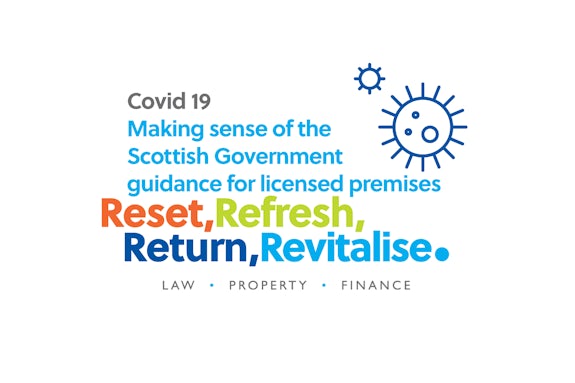By Gilson Gray
March 5, 2021

Further to the First Minister’s announcement on Thursday 18th June, there are many Scottish licensees who are understandably upset and disappointed that beer gardens and street café areas were not able to open on 19th June. They are also frustrated about the lack of certainty in the steps going forward. Albeit 15th July has been suggested as a date when the on trade in Scotland could open, given the announcement on 18th June, there is no guarantee when the on licensed trade will be able to open.
The Scottish Government published guidance on 18th June for the Tourism and Hospitality sector. While this is called “guidance”, some of it is set in stone. Operators need to have taken the actions referred to in the guidance before they can reopen. The guidance itself is very detailed, however, here is a summary of what is required.
Each premises must carry out a risk assessment. If an operator has fewer than five employees, they do not need a written risk assessment, however, licensing boards and their LSO’s may prefer to see a written statement. If there are more than five employees, the risk assessment must be a written document. The guidance stresses the risk assessment must be carried out after discussion with employees and refers to it being a “joint effort between employers and employees”. It must also take into account the health and safety of employees and customers.
The guidance places the responsibility on the business operator to take all “reasonable measures” to ensure physical distancing is established and maintained. This remains two metres distant between anyone not in the same household. Entry must be restricted entry to ensure maintaining a 2 metre distance is possible. Operators must also ensure anyone waiting out with the premises is adhering to the two metre distance necessity. This will require floor and other markings both inside and outside premises.
While there is an existing requirement for employers to consult with employees on health and safety, the guidance puts in place a specific requirement for employers to talk to all employees (from bar staff to cleaners and contractors) on how the employer will manage risks. It states that employers should “constructively engage with employees when carrying out a risk assessment”. Operators should consider the following:
Consider putting in place: screens; one-way systems; two metre zones; staffrooms/areas; PPE provision; hand sanitisers; training and briefings.
Safety checks should be carried out and referred to in the risk assessment before the premises reopen. These include gas and electrical installations, water and ventilation and premises should specifically consider legionella risks and pest control.
Processes should be risk assessed again, even if they have been risk assessed previously. This includes: goods; processes for foods and alcohol; laundry; cleaning and similar. The guidance makes it clear these are different times and all aspects of operation should be considered of new.
A pilot or dry run of new policies and procedures is suggested in the guidance.
If employees are removed from furlough they can be put back onto furlough as long as they were on furlough previously. Employers may have to consider layoffs and redundancy with the appropriate consultation processes that involves. Any consultation must be done carefully to avoid claims later so it is best to take advice.
PPE may be required depending on the outcome of the risk assessment. Staff training to manage risk, explain physical distancing and use PPE is required. PPE must be supplied free of charge to workers who need it, and must fit properly. Guidance should be given on use of PPE and face masks even if this seems obvious. See below re training options.
If any staff or customers are infected with Covid-19, guidelines should be followed. If anyone is within two meters distance for 15 minutes or more, we are told the Scottish Government App will pick this up. If then someone later tests positive for Covid-19, all of those who have been within that distance and timeframe will be contacted through the App and told to self-isolate for 14 days. This could be catastrophic if a full staff team were to be told to self-isolate. While staff should be more than two meters distant from customers, and other staff members, implementing that could be difficult. Prevention is better than reaction. Premises may wish to consider temperature sensors for all staff and customers entering the premises and staff temperature testing throughout a shift as part of the risk assessment.
The Scottish Government has provided a checklist for all businesses, a copy of which is attached.
Training is regarded in the guidance as essential. The Scottish Government sees the training of staff as a way to build a common understanding of requirements within “the new working norm” and to instill confidence in staff that changes made will result in a safe working environment. The guidance states businesses should consider an induction process for all staff covering new and enhanced hygiene and physical distancing measures. Preparing your own training could leave gaps and therefore require that it is redone, costing more in time and resources in the long term.
Contact Jo Millar on 07747 653417 or jmillar@gilsongray.co.uk to discuss.
The information and opinions contained in this article are for information only. They are not intended to constitute advice and should not be relied upon or considered as a replacement for advice. Before acting on any of the information contained in this blog, please seek specific advice from Gilson Gray.

Karen is a solicitor in our Licensing Team specialising in Liquor and Civic Licensing including Short Term Let Licensing. Karen assists and advises our Licensing clients across the country with all forms of licensing matters.